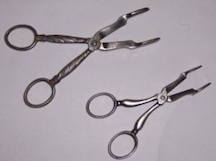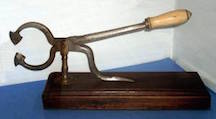One Lump or Two?
by Collette Cameron
Often, when reading historicals (Over four decades now! Gads!) I’ll read something and not think twice about it.
In this instance, I’m talking about lumps of sugar, you know, as in, Do you want one lump or two in your tea?
For years, I mistakenly assumed it was the British way of referring to sugar cubes, which weren’t patented until 1843 by Jakub Krystof Rad who operated a sugar refinery. According to history, his wife sliced her finger cutting a lump of sugar and complained that sugar should come in a convenient size for a teacup. Being a dutiful husband, he created the nifty little units we take for granted today.
 The English, however, had to wait until 1875 for the luxury of sugar cubes on their tea trays.
The English, however, had to wait until 1875 for the luxury of sugar cubes on their tea trays.
Until the late nineteenth century, sugar was purchased in whitish cone-shaped loaves or pieces hacked from a loaf with a chisel and hammer (Hard stuff-those loaves!).
After a lengthy refining process, the sugar was poured into cone-shaped molds with a small hole in the bottom to let the dark syrup drain out. To whiten the sugar, a solution of dissolved loaf sugar or white clay was repeatedly applied to the large end of the loaf, and as the liquid drained through the sugar, it purged any remaining molasses or dark coloring.
Once tapped from the molds, the sugar was wrapped in blue paper to enhance the whiteness.
The largest loaves (called bastards) were lower grade sugar, and as you can imagine, the smaller loaves were extremely expensive.
After purchasing whatever quality of sugar the mistress of the household could afford, how did she fill her sugar basin? She couldn’t very well pass around the entire loaf and ask her guest so take a lick! I did read sometimes larger chunks were simply dunked in the tea because they wouldn’t fit into the cup.
Those were dried and used again. I’m truly hoping not by different guests.
The elite ladies of the ton, weren’t about to get their dainty fingers sticky, no indeed. Plucking a lump or two from a china sugar basin with tongs was much preferred.
But, how to get those neat little lumps?
First, a section of sugar had to be hammered from the loaf, and then nippers—an iron plyer-like tool—were used to lop of a hunk.
That in itself was no easy chore.
The larger cones weighed thirty pounds and measured fourteen inches tall with a three foot base. The higher quality cones used for tea typically weighed between one and three pounds with only a six-inch base and were much more manageable.
Still, no convenient granulated sugar or cubes for those Regency biscuits or tea!
Some nippers came on stands so the user could put their weight into nipping off a piece of sugar. Naturally, tidy, uniform lumps were preferred for serving guests, and that chore generally fell to the mistress of the house or a highly trusted servant.
Sugar, like tea, was expensive and both were often kept in locked chests or caddies to which the mistress kept the keys. Some sugar chests had compartments for powdered and granulated sugar.
Just how did the cook come by powdered and granulated sugar? The lumps were pounded or grated to create granulated sugar and a mortar and pestle was used to make powdered sugar.
Now, don’t you have even more appreciation for those elaborate confections nibbled by callers as they whispered about the latest on dit over a steaming cup of sugar-sweetened tea?
In my new release, Virtue and Valor (Highland Heather Romancing a Scot, Book 2), Isobel enjoys a morning cup of tea.
About Virtue and Valor (Highland Heather Romancing a Scot Series, Book 2)
Bartholomew Yancy never expected to inherit an English earldom and had no intention of marrying. Now, the Earl of Ramsbury and last in his line, he’s obligated to resign his position as England’s War Secretary, find a wife, and produce an heir. Only one woman holds the least appeal: Isobel Ferguson, an exquisite Scotswoman. Brought to Scotland to mediate between feuding clans, he doggedly woos her.
Disillusioned with men pursuing her for her attractiveness, rather than her unusual intellect, Isobel has all but abandoned any hope of finding a husband in the Highlands. Not only does she believe Yancy no different than her other suitors, he’s a notorious rake. She’s been told he’s practically betrothed. Therefore, his interest in her cannot possibly be honorable, and so she shuns his attentions.
When Isobel is mistakenly abducted by a band of rogue Scots, Yancy risks his life to rescues her. To salvage her compromised reputation, her brother and father insist she marry him. Yancy readily agrees, but Isobel—knowing full well she’s fated for spinsterhood by refusing his offer— won’t be coerced into marriage.
Excerpt
Pouring a cup of tea, Isobel inhaled the heady scent. She added two lumps of sugar and a dash of milk before stirring the contents.
 She adored the smell of hot tea. The scent reminded her of her childhood. Every morning, Mother had gathered the children around her for a cuddle and enjoyed a cup with them.
She adored the smell of hot tea. The scent reminded her of her childhood. Every morning, Mother had gathered the children around her for a cuddle and enjoyed a cup with them.
Lifting the hand-painted teacup to her lips, Isobel eyed the disgruntled maid stomping about the bedchamber, casting her astringent glances every now and again.
“Suppose this means ye be plannin’ on wallowin’ about in the muck too.” Maura did exaggerate so.
Isobel pointedly focused her attention on the ceiling to keep from rolling her eyes.
“I do not wallow, as you know full well.” She wiggled her free hand at the maid. “My hands and nails shan’t even get dirty.”
“Ladies do not collect rocks and dead things turned to rocks.” Maura harrumphed and trundled her way to the rumpled bed. She shuddered dramatically. “It be unnatural, I tell ye. Creatures turned to stone. They be cursed. The same as Lot’s wife in the Good Book.”
“She was turned into a pillar of salt, not stone.” Isobel suppressed a chuckle and spread jam over a roll.
“Humph. Stone. Salt. It makes no matter to me.”
Maura patted the purple and white coverlet into place then adjusted a couple of pillows to her satisfaction. “A curse is a curse—like those Callanish sinners turned to stone for their heathen activities on the Sabbath.”
“Maura, that’s Superstitious drivel. The Callanish Circle was used to track lunar activity.”
Clearly baffled, Maura pursed her lips and squinted at Isobel. “Loony activity?”
“Lunar. The path of the moon.” Isobel smiled, pointing with a forefinger and drawing an arc in the air.
“The sinner’s-to-stone business is nonsense. Simply a silly legend spread by the early Kirk of Scotland to discourage rites they didn’t approve of.”
About the Author
 Bestselling, award-winning author, Collette Cameron, has a Bachelor of Science in Liberal Studies and a Master’s in Teaching. Author of the Castle Brides Series, Highland Heather Romancing a Scot Series, and Conundrums of the Misses Culpepper Series, Collette writes Regency and Scottish historicals and makes her home in the Pacific Northwest with her husband and five mini-dachshunds. Mother to three and a self-proclaimed Cadbury Chocolate chocoholic, Collette loves a good joke, inspirational quotes, flowers, trivia, and all things shabby chic or cobalt blue. You’ll always find dogs, birds, quirky—sometimes naughty—humor, and a dash of inspiration in her novels.
Bestselling, award-winning author, Collette Cameron, has a Bachelor of Science in Liberal Studies and a Master’s in Teaching. Author of the Castle Brides Series, Highland Heather Romancing a Scot Series, and Conundrums of the Misses Culpepper Series, Collette writes Regency and Scottish historicals and makes her home in the Pacific Northwest with her husband and five mini-dachshunds. Mother to three and a self-proclaimed Cadbury Chocolate chocoholic, Collette loves a good joke, inspirational quotes, flowers, trivia, and all things shabby chic or cobalt blue. You’ll always find dogs, birds, quirky—sometimes naughty—humor, and a dash of inspiration in her novels.
Her motto for life? You can’t have too much chocolate, too many hugs, too many flowers, or too many books. She’s thinking about adding shoes to that list.
Connect with Collette:
Website • Blue Rose Romance Blog • Twitter • Facebook • Newsletter
Resources:
http://www.nytimes.com/2012/11/18/magazine/who-made-that-sugar-cube.html?_r=0
http://www.oldandinteresting.com/sugar-nippers.aspx
https://en.wikipedia.org/wiki/Sugarloaf
https://regencyredingote.wordpress.com/2008/11/14/take-your-lumps-sweet-ones/
http://etiquipedia.blogspot.com/2014/04/regency-era-etiquette-and-when-sugar.html
Images courtesy of Wikimedia Commons








While I knew that, it’s a nice reminder. Especially with the tools showcased.
Denise
LikeLike
Denise, I keep thinking how much work it was to bake anything.
LikeLike
Thank you so much for having me back again!!
LikeLike
My pleasure entirely, Collette! Fabulous post!
LikeLike
Fascinating- thank you for sharing! Congrats on the release!
LikeLike
I’d be the woman cutting herself to get her sugar!
LikeLike
Thank you so much ! I just love articles like this . It gives you such an appreciation for all the work that went into everyday that we take for granted 🙂
LikeLike
I know! Grating sugar or hammering it to make cookies would have me thinking twice about baking.
LikeLike
Hi Miss Collete,
Will Virtue and Valor be out in paperback?It seems it came out in Kindle format but I’m unable to purchase it as it’s only made available to certain countries and Im from Singapore.
Thanks!
LikeLike
Have you tried Kobo?
LikeLike
Cindy, paperback should be available in December. I hope!
LikeLike
What fascinating information! I can imagine the effort needed to get that sugar into small enough units for the tea tray.
LikeLike
I imagine it was hard as a rock and took a bit of doing. I’ll never take granulated sugar for granted again.
LikeLike
Love it! I love reading about tidbits like this. I had, oddly enough, worked close to a sugar manufacturer when I lived down in Miami, and he’d told me all about the history of sugar. He had some whoppers about pirates and sugar I couldn’t retell without blushing. Such fun sweet stuff!
LikeLike
It makes their lives seem so real, doesn’t it, Red?
LikeLike
Reblogged this on Ella Quinn ~ Author and commented:
Great post on sugar lumps!!
LikeLike
What a great post, Collette!! I shared!
LikeLike
Thanks so much, Ella!
LikeLike
That is so cool!
LikeLike
I’ll never look at a sugar cube the same way. I also learned that sugar bowls were for granulated sugar while sugar basins were for the “lumps”.
LikeLike
Reblogged this on Duchess of Romance.
LikeLike
Thank you, Janet!
LikeLike
Really interesting history! Loved this article!
LikeLike
Thanks, Tamara. This little peeks into history are why I love writing historical romance.
LikeLike